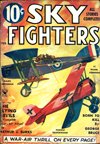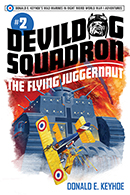“Sky Fighters, February 1935″ by Eugene M. Frandzen
Eugene M. Frandzen painted the covers of Sky Fighters from its first issue in 1932 until he moved on from the pulps in 1939. At this point in the run, the covers were about the planes featured on the cover more than the story depicted. On the February 1935 cover, It’s a battle of the Bristol Fighter F2B and the Siemens Halske D4!
The Ships on the Cover
THE Bristol Fighter F2B  was a plane which any Englishman can remember with justifiable pride. It was a two-seater fighter brought out during 1917 and some of them were still flying a few years back. As a war bus this square fuselage job was in a class by itself. One man could take it into a mixup and outfly most of the enemy scouts.
was a plane which any Englishman can remember with justifiable pride. It was a two-seater fighter brought out during 1917 and some of them were still flying a few years back. As a war bus this square fuselage job was in a class by itself. One man could take it into a mixup and outfly most of the enemy scouts.
With the rear gunner in the Bristol Fighter it was about the most dangerous thing slicing through the skies. It mowed down its enemies in such great numbers that the German flyers gave it the right of way whenever possible.

The British and Colonial Aeroplane Co., manufacturers of the Bristol was formed in 1910 by the late Sir George White, Bart, who incidentally was the pioneer of electric tramways in Great Britain.
The Bristol Fighter was the first ship of any country which could match single-seater scouts in speed, maneuverability and ease of handling.
Four-Bladed Propeller
The sleek little red plane zooming underneath the Bristol on the cover is a Siemens-Halske D-4 pursuit ship. It was made by one of the many branches of the great Siemens Electrical Company of Germany, comparable to our own General Electric Co. The motor was a 200 h.p. Halske rotary. To get greater efficiency with the geared down motor a four-bladed propeller was used. The ailerons were actuated by torque tubes. The Siemens firm also produced those multi-engined giant bombers, the Siemens-Schuckert and Siemens-Steffen.

The Bristol Fighter was made by the firm that had been founded by a pioneer of the electric street car; the Siemens-Halske by the electric moguls of Germany. Therefore it was fitting and interesting that these two ships should be pitted and allowed to scratch and tear at each other as war planes are in the habit of doing.
The Battle Opens!
With the Siemens having a slight edge in speed the battle opened. The Bristol back gunner was a menace to the German who used his slight extra speed finally to maneuver so that he placed his streamlined little job under the tail of the larger Bristol. Two spitting streams of bullets poured from his Spandaus. One of those tiny pellets tore through the British observer’s body.
He slumped in his pit, out. Down dove the Siemens, came back from under and in front of the Bristol. Slugs spattered through the two-seater’s floorboards. The Bristol pilot quickly lashed his controls, turned, and holding his buddy from slipping overboard brought the twin Lewis guns over the side. The Siemens, a streak of red, flashed by so close that the left elevator of the Bristol and the left wing tip of the Siemens nearly brushed together.
A Short-Lived Grin
The German looked up, grinned. The grin didn’t last a shaved part of a split second. A single Lewis gun churned slugs at point-blank range into the German ship. One smashed the pilot’s left shoulder.
Rapidly the ships flew in opposite directions. They had fought a draw. Each carried a wounded man to be patched up and flung again into the arena where knockouts are daily events and draws are few and far between.

Sky Fighters,February 1935 by Eugene M. Frandzen
(The Ships on The Cover Page)
Next time, Mr. Frandzen features the French Deperdussin vs. the German D.F.W.!





